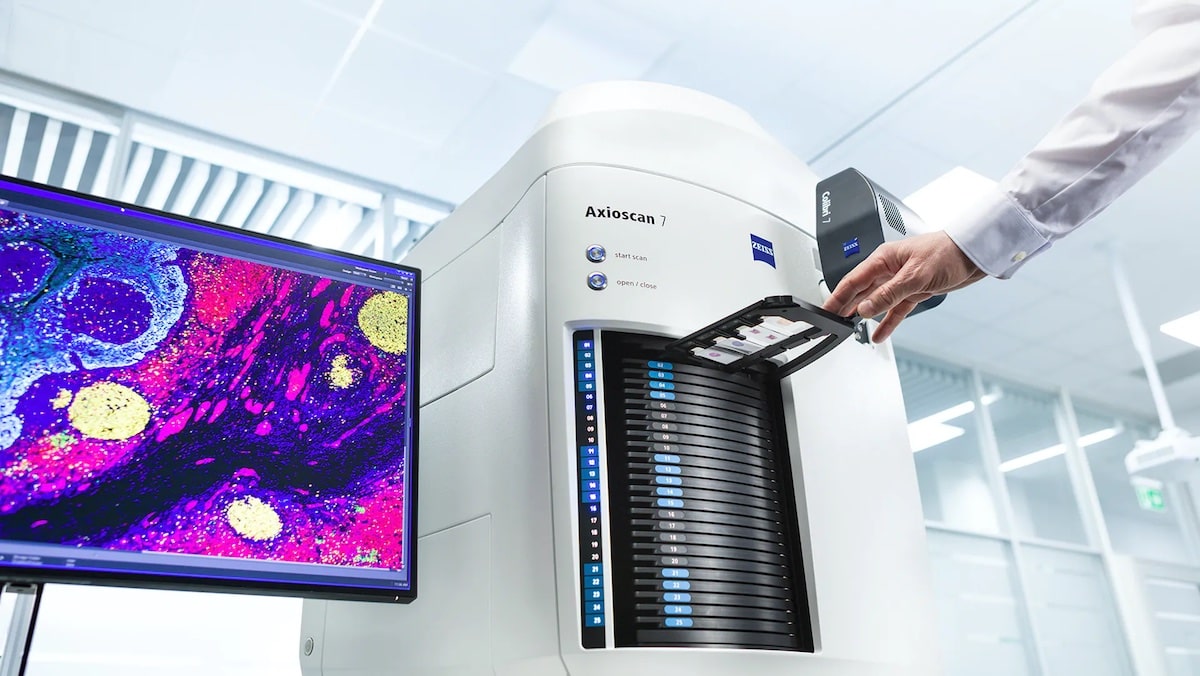Members Login

Channels
Special Offers & Promotions
ZEISS Introduces New Microscopy Slide Scanner
ZEISS Axioscan 7 combines scanning performance with application freedom
With the release of ZEISS Axioscan 7, ZEISS presents its next-generation slide scanner for the automated digitization of microscopy samples. Following its successful predecessor ZEISS Axio Scan.Z1, ZEISS Axioscan 7 provides significant improvements in almost every aspect: a new acquisition engine for higher scan speeds, a broader range of imaging modes for more application flexibility, extended capabilities for advanced fluorescence imaging, and a dramatically improved user experience.
The demand for creating high-quality virtual microscopy slides in an automated and reliable way has been increasing in life science research labs, core imaging facilities, and in pharma research. ZEISS Axioscan 7 addresses both the need for reliable 24/7 scan performance as well as highest imaging quality across a multitude of applications by combining continuously high scan speeds and simple operation with application-specific customization options.
Additional brightfield contrast methods enable more comprehensive sample characterization
ZEISS Axioscan 7 allows automatic switching between different brightfield imaging modes to adapt to the requirements of different applications while maintaining optimal scanning performance. Circular and linear polarization are now fully supported, opening a new range of experiments and modality combinations. Transfer of Intensity Equation (TIE) is a new digital method for contrast generation in transparent samples, adding phase and relief contrast to the wealth of imaging modes. TIE enables detection of transparent tissues with little to no contrast in regular brightfield mode and can therefore aid experiments with sensitive fluorescent dyes by protecting the samples from bleaching and accelerating the subsequent fluorescence imaging process with very fast focusing.
Highly productive fluorescence imaging
Speed, gentle treatment, and the optimal wavelength are critical when it comes to multispectral fluorescence imaging. ZEISS Axioscan 7 employs swift and reproducible LED illumination, fast filter wheels, and a sophisticated filter concept to efficiently separate a broad range of fluorescence channels. Two light sources – the super-fast 7 wavelengths LED light source ZEISS Colibri 7 and the white light LED light source X-Cite Xylis – provide flexibility in selecting the appropriate wavelengths. Newly designed filter sets for multiplexing applications allow for clear spectral delineation without the need for additional software to separate fluorescent channels.
Advanced cameras enhance image quality
The new slide scanner is equipped with the most advanced Peltier-cooled cameras from the ZEISS Axiocam portfolio to support brightfield and fluorescence applications with state-of-the-art imaging performance. With 55 frames per second acquisition speed and a large field of view, ZEISS Axiocam 705 color rapidly accomplishes brightfield and polarization imaging tasks. ZEISS Axiocam 712 mono offers small pixels (3.45 µm), fully capturing the resolution potential of the high numerical aperture optics, and very low readout noise, making this camera the preferred choice for advanced fluorescence imaging applications.
A sound investment
The demand for higher throughput and screening capability drives the charge towards automated instruments. ZEISS Axioscan 7 provides automation without sacrificing flexibility or the high quality of images needed to attract a very wide range of users to core imaging facilities. With approaches as varied as multiplexing in tissue sections to polarization in rock sections, the new slide scanner attracts users from departments as diverse as life science and geology. The powerful combination of accommodating a broad user base with robust design places ZEISS Axioscan 7 as a top performer when it comes to usage hours, and it quickly pays for itself.
Video - ZEISS Axioscan 7 - Product Trailer
About ZEISS
ZEISS is an internationally leading technology enterprise operating in the fields of optics and optoelectronics. In the previous fiscal year, the ZEISS Group generated annual revenue totaling 6.3 billion euros in its four segments Semiconductor Manufacturing Technology, Industrial Quality & Research, Medical Technology and Consumer Markets (status: 30 September 2020).
For its customers, ZEISS develops, produces and distributes highly innovative solutions for industrial metrology and quality assurance, microscopy solutions for the life sciences and materials research, and medical technology solutions for diagnostics and treatment in ophthalmology and microsurgery. The name ZEISS is also synonymous with the world's leading lithography optics, which are used by the chip industry to manufacture semiconductor components. There is global demand for trendsetting ZEISS brand products such as eyeglass lenses, camera lenses and binoculars.
With a portfolio aligned with future growth areas like digitalization, healthcare and Smart Production and a strong brand, ZEISS is shaping the future of technology and constantly advancing the world of optics and related fields with its solutions. The company's significant, sustainable investments in research and development lay the foundation for the success and continued expansion of ZEISS' technology and market leadership. ZEISS invests 13 percent of its revenue in research and development – this high level of expenditure has a long tradition at ZEISS and is also an investment in the future.
With over 32,000 employees, ZEISS is active globally in almost 50 countries with around 30 production sites, 60 sales and service companies and 27 research and development facilities. Founded in 1846 in Jena, the company is headquartered in Oberkochen, Germany. The Carl Zeiss Foundation, one of the largest foundations in Germany committed to the promotion of science, is the sole owner of the holding company, Carl Zeiss AG.
Media Partners



